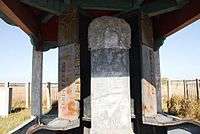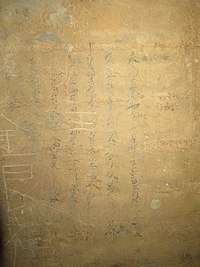List of Jurchen inscriptions
The list of Jurchen inscriptions comprises a list of the corpus of known inscriptions written in the Jurchen language using the Jurchen script. There are ten monumental inscriptions, mostly dating to the Jin dynasty (1115–1234), but the latest monument dates to the early Ming Dynasty (1413). There are also a number of short Jurchen inscriptions on portable artefacts such as mirrors, seals and paiza. In contrast with inscriptions in Khitan scripts, there are no known examples of stone-inscribed epitaphs in the Jurchen script.

Rock inscription in Jurchen dated 1196 at Serven Khaalga, Bayankhutag, Mongolia. The inscription relates to Genghis Khan's alliance with the Jin against the Tatars.
Monumental inscriptions in the Jurchen script
| Monument | Date | Place of discovery | Year of discovery | Current Location | Description |
|---|---|---|---|---|---|
| Monument commemorating the victory of Emperor Taizu of Jin over the Khitans in 1114 (Da-Jin desheng tuosong bei 大金得勝陀頌碑)  |
1185 | Shibei Weizi, Fuyu County Jilin 45.346°N 125.612°E |
known since about 1820–1850 | Jilin Provincial Museum | Bilingual Chinese and Jurchen memorial with 30 lines of Chinese text on the front, and 33 lines of Jurchen text on the back, about 1,500 Jurchen characters in total.[1][2] |
| Monument recording the names of successful candidates for the degree of jinshi in 1224 (Nüzhen jinshi timing bei 女真進士題名碑) |
1224 | Yantaihe 宴台河, Kaifeng Henan 34.806°N 114.422°E |
known since the early 14th century | Erected at the Confucian Temple (Wen Miao 文廟) in Kaifeng | Originally a bilingual memorial, but the original Chinese text was deleted and re-engraved with a new text commemorating the restoration of the Temple of the River Spirit 河神廟 during the Ming dynasty. The Jurchen text comprises about 1,100 characters.[2][3] |
| Monument commemorating a picnic held by Aotun Liangbi (Aotun Liangbi jianyin bei 奧屯良弼餞飲碑) |
1210 | Unknown (originally in the collection of Luo Zhenyu) | known since 1931 | National Museum of China, Beijing | Chinese inscription by Aotun Liangbi 奧屯良弼 in 4 lines, dated 1206, on the front; and a Jurchen inscription in 3 lines (about 60 characters) on the left side, dated 1210, added by Aotun Liangbi's friend Bu Xiuhong 卜修洪.[2][4] |
| Monument inscribed with a poem by Aotun Liangbi (Aotun Liangbi shi bei 奧屯良弼詩碑) |
Youde Temple 佑德觀, Penglai City Shandong 37.832°N 120.753°E |
1960s | Eight-line poem with preface by Aotun Liangbi 奧屯良弼, comprising about 170 characters in total. The poem is written in Aotun Liangbi's cursive calligraphy, and was inscribed on the orders of his friend Bu Xiuhong.[5][6] | ||
| Two rock inscriptions at Hailong (Hailong Nüzhen guoshu moya 海龍女真國書摩崖) |
1167 | Yangshulin Mountain 楊樹林山, Meihekou Jilin 42.295°N 125.450°E |
known since about 1875–1908 | In situ | Bilingual Chinese and Jurchen inscription commemorating the defeat of the Khitans by Emperor Taizu of Jin (15 Chinese characters and about 20 Jurchen characters); and a Jurchen inscription of about 80 characters dated 1167 commemorating the establishment of an office in 1116.[7][8] |
| Monument commemorating the construction of a Buddhist temple (Qingyuanjun Nüzhen guoshu bei 慶源郡女真國書碑) |
1138–1153 | Buddhist temple, Kyongwon North Korea 42.8°N 130.2°E |
1918 | Seoul Museum of History | List of names and titles of people who contributed to the construction of the Buddhist temple where the monument was originally found. 22 lines on four sides, but the top of the monument is missing so the inscription is incomplete, with about 500 characters remaining.[8][9] |
| Rock inscription commemorating the presentation of a Buddhist statue (Beiqing Nüzhen guoshu moya 北青女真國書摩崖) |
1218 | Mount Kwansan 串山, Pukchong North Korea 40.25°N 128.30°E |
1911 | In situ | Jurchen inscription comprising about 40 characters.[8][10] |
| Yongning Temple Stele Monument commemorating the foundation of Yongning Temple (Yongningsi bei 永寧寺碑) |
1413 | Tyr, Khabarovsk Krai Russia 52.93°N 139.76°E |
known since 1639 | Vladivostok Museum | Main inscription in Chinese on the front, and secondary inscriptions (approximate translations of the Chinese) in Mongolian and Jurchen on the back (about 700 Jurchen characters); with the mantra Om mani padme hum written in Chinese, Mongolian, Tibetan and Jurchen on both sides.[8][11] |
| Tomb memorial for the Zhaoyong General (Zhaoyong dajiangjun tongzhi Xiongzhou jiedushi mubei 昭勇大將軍同知雄州節度使墓碑) |
1186 | Xiaocheng, Shulan Jilin 44.235°N 127.155°E |
1979 | 1 line of Jurchen text (21 characters).[12] | |
| Rock inscription commemorating a victory by Wanyan Xiang (1140–1202) (Wanyan Xiang jigong moya bei 完顏襄記功摩崖碑)  |
1196 | Bayankhutag, Khentii Province Mongolia 47.17°N 110.82°E |
1979 | 9 lines of Jurchen text (about 140 characters), with Chinese translation nearby.[12] | |
| Rock Inscription at Shenmu (Shanbei shiku moya tike 陝北石窟摩崖題刻) |
c. 1228 (date on an adjacent Chinese inscription) | Shenmu, near Yulin Shaanxi 38.85°N 110.52°E |
2014 | In situ ? | Jurchen inscription on a rock face outside a cave, comprising about 30 lines of about 20 characters each, but most of the inscription has been lost due to damage, and only the first four lines are relatively complete. About 200 Jurchen characters survive, which is about a third of the original inscription.[13] Also two Jurchen characters on an adjacent inscription with snake patterns.[14] |
| Rock Inscription on the bank of the River Arkhara | 1127 | River Arkhara, Amur Oblast Russia 49.63963°N 130.60997°E |
2003 (identified as Jurchen in 2014) | In situ | One short inscription (24 characters on 3 lines) written in ink on a rock face.[15] |
Other inscriptions in the Jurchen script
| Object | Date | Place of discovery | Year of discovery | Current Location | Description |
|---|---|---|---|---|---|
Ink inscriptions on a pagoda |
White Pagoda, Hohhot Inner Mongolia 40.84°N 111.90°E |
Inscriptions in cursive Jurchen written in ink on the inner wall of the 6th storey of the Ten Thousand Copies of the Huayan Sutra Pagoda (Wànbù Huáyánjīng Tǎ 萬部華嚴經塔).[16] | |||
| Rock inscriptions | Du'erji, Horqin Right Middle Banner Inner Mongolia 45.20°N 121.16°E |
[17] | |||
| Rock inscriptions | Wulanmaodu, Horqin Right Front Banner Inner Mongolia 46.39°N 121.20°E |
[17] | |||
| Inscription on a sacrificial platform | Heaven Lake, Fusong County Jilin 42.025°N 128.055°E |
3 Jurchen characters on a Jin dynasty sacrificial platform at the edge of the lake. | |||
| Medallion | Unknown | Unknown (only known from a drawing in a Ming Dynasty catalogue of molds for making ink) | Medallion with the Jurchen translation of a Chinese couplet, "When a wise king is heedful of virtue, foreigners from all quarters come as guests" (Ming wang shen de, si yi xian bin 明王慎德, 四夷咸賓).[18] | ||
| Seal of the head of the Kechenshan 100 households (Kechenshan mouke yin 可陳山謀克印) |
1178 | Helong, Yanbian Jilin 42.55°N 129.00°E |
1916 | Official seal with Chinese inscription on the seal face, and a Jurchen inscription of 13 characters on the side.[19] | |
| Seal of the head of the Yigaidagehe 100 households (Yigaidagehe mouke yin 移改達葛河謀克印) |
1179 | Palace Museum, Beijing | Official seal with Chinese inscription on the seal face, and a Jurchen inscription of 7 characters on the side.[19] | ||
| Seal of the head of the Hetouhulunhe 100 households (Hetouhulunhe mouke yin 河頭胡論河謀克印) |
1176 | Tianjin Museum | Official seal with Chinese inscription on the seal face, and a Jurchen inscription of 6 characters on the side.[19] | ||
| Seal of the head of the Hezhuohailuan 100 households (Hezhuohailuan mouke yin 和拙海欒謀克印) |
1178 | Tianjin Museum | Official seal with Chinese inscription on the seal face, and a Jurchen inscription of 8 characters on the side.[19] | ||
| Seal of the head of the Jiahunshan 100 households (Jiahunshan mouke yin 夾渾山謀克印) |
1178 | Palace Museum, Beijing | Official seal with Chinese inscription on the seal face, and a Jurchen inscription of 7 characters on the side.[19] | ||
| Seal of the head of the Milidiehe 100 households (Milidiehe mouke yin 迷里迭河謀克印) |
1179 | Harbin Heilongjiang 45.85°N 126.65°E |
1986 | Harbin Cultural Office | Official seal with Chinese inscription on the seal face, and a Jurchen inscription on the side.[20] |
| Seal of the head of the Supakunshan 100 households (Supakunshan mouke yin 速怕昆山謀克印) |
1222 (Eastern Xia) | Aolimi Ancient City (奥里米古城), Suibin County Heilongjiang 47.290°N 131.815°E |
1987 | Hegang Cultural Relics Office | Official seal with Chinese inscription on the seal face, and a Jurchen inscription on the side.[20] |
| Bronze mirror (Kouwei meng'an tongjing 叩畏猛安銅鏡) |
Song dynasty mirror with a later Jurchen inscription ("head of Kouwei 1,000 households") engraved along the edge.[21] | ||||
| Bronze mirror | Chengzi He 承紫河, Mishan Heilongjiang 45.44°N 132.37°E |
1974 | Mirror with a 9 character Jurchen inscription engraved along the edge.[16] | ||
| Silver paiza | Shaygino, Primorsky Krai Russia 43.33°N 133.00°E |
1976 | Silver pass with a Jurchen inscription in five characters reading gurun ni xada-xun meaning "Trust of the Country".[22] | ||
gollark: What is even the point of `env` if it doesn't, actually?
gollark: How magentized.
gollark: https://media.discordapp.net/attachments/800374765990051870/870278963082190868/very.png
gollark: Also, their art is excellent.
gollark: They went from knowing, as far as I can tell, basically nothing about programming, to decent competence in a bunch of difficult things over a few months.
See also
Notes
Footnotes
- Kane 1989, pp. 43–45
- Jin Guangping & Jin Qizong 1980, p. 37
- Kane 1989, pp. 46–50
- Kane 1989, pp. 51–53
- Kane 1989, pp. 54–55
- Jin Guangping & Jin Qizong 1980, pp. 37–38
- Kane 1989, pp. 56–59
- Jin Guangping & Jin Qizong 1980, p. 38
- Kane 1989, pp. 59–62
- Kane 1989, pp. 62–63
- Kane 1989, pp. 63–68
- Kane 1989, p. 69
- Wang, Fei 王斐 (24 January 2016). "榆林真有好东西 女真文字摩崖题刻 属首次发现". Retrieved 18 August 2017.
- "神木發現女真文字摩崖題刻 保留女真文字178個". 25 December 2016. Retrieved 18 August 2017.
- Aisin-Gioro, Ulhicun; Yoshimoto, Michimasa 吉本道雅 (2017). ロシア・アルハラ河畔の女真大字墨書:女真・契丹文字遺跡をたどって. Kyoto: Hōyū shoten. pp. 28–51.
- Jin Guangping & Jin Qizong 1980, p. 40
- Jin Guangping & Jin Qizong 1980, p. 41
- Kane 1989, pp. 71–72
- Jin Guangping & Jin Qizong 1980, p. 39
- Usuki Isao 臼杵勲. "北東アジア出土官印表(稿)". Retrieved 28 December 2010.
- Jin Guangping & Jin Qizong 1980, pp. 39–40
- Kane 1989, pp. 72–73
References
- Jin Guangping 金廣平; Jin Qizong 金啓孮 (1980). 女真語言文字妍究 (in Chinese). Wenwu chubanshe.
- Kane, Daniel (1989). The Sino-Jurchen Vocabulary of the Bureau of Interpreters. Indiana University, Research Institute for Inner Asian Studies. ISBN 978-0-933070-23-3.
External links
| Wikimedia Commons has media related to Jurchen inscriptions. |
This article is issued from Wikipedia. The text is licensed under Creative Commons - Attribution - Sharealike. Additional terms may apply for the media files.